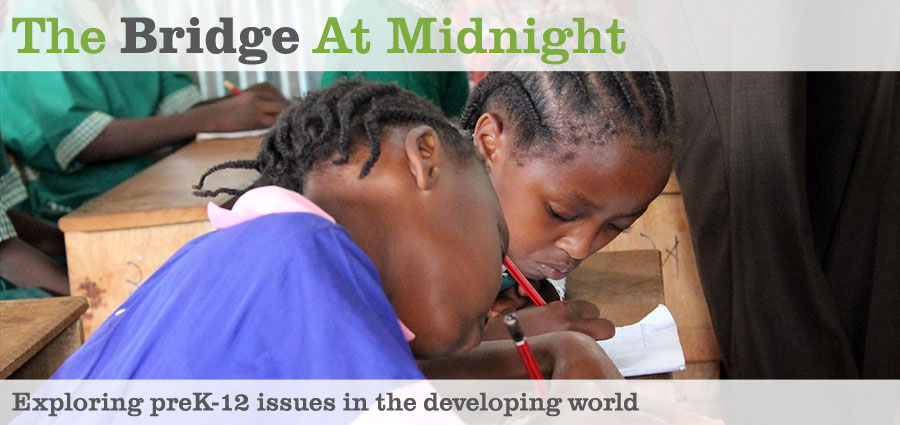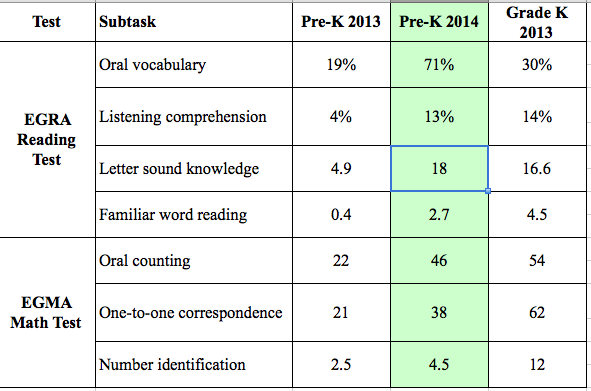Promising Results with Bridge 4-year-olds
Posted: August 21st, 2014 | Author: Michael Goldstein | | No Comments »
Hi folks,
It’s been a while! Busy. Sorry for not posting much.
If you recall, Bridge made some changes in the 2014 school year to our Nursery curriculum (our 4-year-olds). The changes have been popular with both parents and teachers. But what about the data? Are kids learning more?
Now that the school year is 2/3 through, we have a sense of things. Though there are imperfections in our measurement system (we’re bringing on some top economists to measure us better), my view is the data quality is at least “pretty good.”
The results look quite good.
Not only are the Nursery kids far ahead of the Nursery kids from 2013, but it looks like they’ll finish the year ahead of our Kindergarten (pre-Unit) kids from 2013. “Lap the field” in a manner of speaking.
Big props to Alex and his team. How’d they achieve the gains? He writes:
The redesign focused on accelerating both language acquisition and academic learning in Nursery by transforming the individual pupil’s daily experience.
This consisted of three principal innovations reflecting our high expectations for what teachers and pupils can accomplish.
1. Teaching without translation.
Previously, teachers used simultaneous translation of academic instruction in English to Kiswahili to aid immediate comprehension, but that came at the expense of long-term English language acquisition.
New teacher training and curriculum emphasizes teaching English curriculum only in English and Kiswahili curriculum only in Kiswahili. Instead of relying on translation, teachers learned to use a host of language acquisition strategies including expression, actions, visuals, and rhymes to ensure pupil understanding.
At our teacher re-training in December 2013, we also gave teachers the experience of learning basic components of a foreign language without interpretation. This first-hand experience was key to teachers adopting the mindset that language learning is possible, and more effective, without translation.
2. Replace choral response with individual skills practice.
Choral response to teacher questions is the most familiar form of pupil participation in learning. And it requires no printed materials. However, its impact is limited. Often, pupils merely parrot the correct responses of a handful of more advanced pupils.
In the new curriculum, we kept the teacher explanation and demonstration, but replaced most of the choral response with individual practice.
For example, in a lesson designed to teach letter sounds, instead of teachers saying sounds and asking the pupils to identify the letter chorally, we provide pupils with sets of letters printed in random order in a practice book.
The teacher says a letter sound and each pupil points to the letter that makes that sound in their practice books. The teacher circulates to ensure correct answers and rapidly cycles through multiple letter sounds. In this way, all pupils’ practice and master fundamental skills in reading, as well as in other content areas, without relying on their peers.
This shift from choral response to individual practice required developing innovative reusable learning materials for pupils. Unlike workbooks, each page in our practice books can be used again and again – rather than just once – to reinforce learning.
3. Teach at a faster pace.
We roughly doubled the pace of in-class instruction. Removing translation, of course, facilitated part of this change. We also shortened daily practice exercises, but extended them across more days.
Pupils at this age need repeated practice with a skill over multiple days or weeks to master it. But the daily dosage does not need to be high to get results.
So, rather than drilling a single concept for 20 minutes straight, then moving to a different concept the next day, lessons feature short bursts of practice of the same skill repeated across multiple days. This allows for faster-paced instruction, which ultimately means more instruction. Scripts are much longer this year for the same amount of time.
4. Assess one-on-one.
Teachers constantly assess pupil learning with the new curriculum, both via questioning and pupil participation at the chalkboard. The most powerful daily assessment occurs as teachers monitor individual pupil practice with the practice books referenced above.
In addition, we trained teachers to assess pupils one-on-one on language, literacy and numeracy at mid-term and end-term for all three terms of the academic year.
This provides teachers and parents with valuable information on how pupils are progressing and helps teacher identify pupils for additional attention. Most of all, it provides concrete evidence of the effectiveness of classroom instruction.
In addition to these innovations, we have taken steps to assist parents in supporting their children’s learning.
For example, we provided reusable practice book pages – explained above – in pupil homework books that mimic our in-class pupil practice books. And, teachers have trained parents to revise classroom learning at home each day using what we call ‘parent pages’ in the homework book.
Based on overwhelmingly positive response to Term 2 pilot, we are providing more ‘parent pages’ in Term 3. And we are eager to see the impact.



Leave a Reply